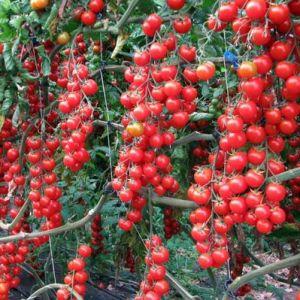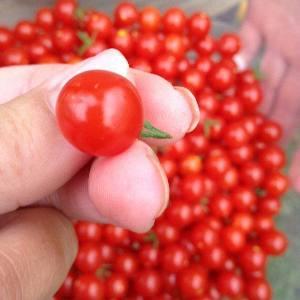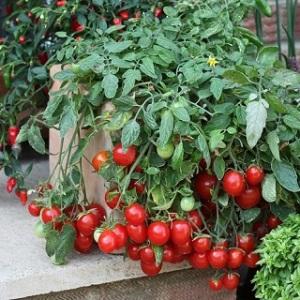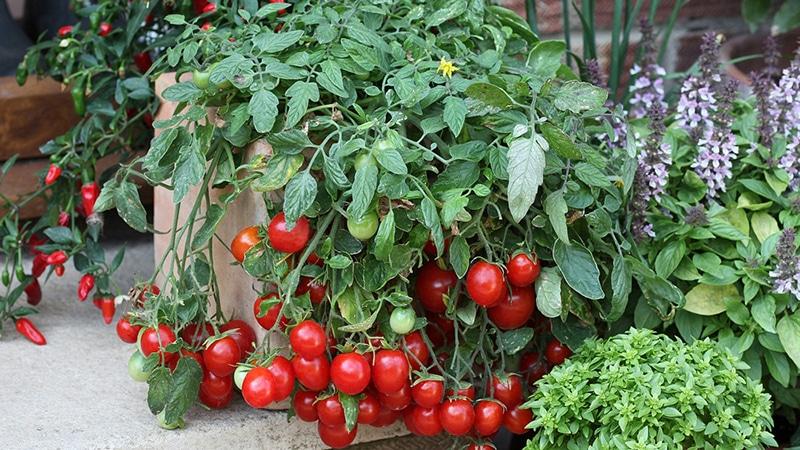It is easy and simple to grow a tomato "Thumbelina" on a windowsill or summer cottage according to instructions from experienced farmers
If you like Cherry tomatoes, you will definitely be delighted with Thumbelina tomatoes. This variety has small, neat and very tasty fruits. Children will surely like them. Decorating snacks, meat or fish with them is a pleasure. Tomato salads Thumbelina give an unusual taste and exquisite look.
In addition, the bushes will perfectly decorate your windowsill or balcony. Thanks to their bright green foliage, they create a feeling of comfort and freshness.
The content of the article
Description of the variety
Variety Thumbelina determinant and tall... The bushes reach a height of 1.5 meters, and sometimes even 2. Therefore, it is worth pinching the top at a plant height of 1.5 m - this will favorably affect the development of fruits.
Reference. Determinant tomato varieties require the removal of growth points.
According to the rate of ripening, Thumbelina is referred to as early maturing. The first harvest is obtained 90 days after planting the seeds.
This variety is grown in greenhouses or at home, for example, on a balcony.
Distinctive features
The main feature of the variety is, of course, the size of the fruit. Miniature tomatoes look spectacular. In addition, they ripen synchronously. They are collected with a whole brush.
Fruit characteristics, yield
Tomatoes Thumbelina are round, weighing 15-20 g. Ripe tomatoes are of a beautiful red color. Nice to the touch, smooth and firm. This variety is considered dessert. They will delight you with their excellent sweet taste.
On each brush, about 15 tomatoes are tied.
The variety gives the maximum yield when grown in 2-3 stems. With proper care, up to 4.7 kg can be collected from one square meter.
How to grow seedlings
Like many other varieties of nightshade, Thumbelina is sown on seedlings in March, after preparing the seeds and soil.
Seed preparation
Before sowing, the planting material should be disinfected in order to get rid of diseases that live on the surface of the seeds. Prepare a weak manganese solution and place the grains in it for 3 minutes. Then rinse them, wrap them in wet gauze and leave them in a warm place for 3 days.
Do not let the gauze dry; spray it with room temperature water.
After the seeds have hatched, transplant them into prepared soil.
Capacity and soil
For sowing seeds, buy a special potting soil mixture or prepare it yourself. Mix garden soil, sand, peat, or humus and add some mineral fertilizers and charcoal.
For seedlings, it is initially convenient to use boxes, and it is better to dive plants in glasses of 200-250 g.
Sowing
Plant the sprouted seeds in grooves 1 cm deep at a distance of 2 cm from each other. Then sprinkle with earth.
Important.The soil should be moist when planting.
For early germination of seeds, cover the boxes with foil or thin glass. Place the seedling boxes in a warm place and keep the temperature at + 20-25 degrees. The first shoots will appear in 5-6 days.
Growing and care
 After the sprouts appear, remove the film or glass. Take care of the lighting. If the room where the seedlings are standing is not bright enough, put additional light sources. It is better to use a special phytolamp, but in the absence of such, ordinary ones will do.
After the sprouts appear, remove the film or glass. Take care of the lighting. If the room where the seedlings are standing is not bright enough, put additional light sources. It is better to use a special phytolamp, but in the absence of such, ordinary ones will do.
Spray the soil regularly with a spray bottle to maintain proper moisture levels.
Ventilate the seedling room at night, but avoid drafts and low temperatures.
Start picking with the appearance of 2-3 leaves on the plants. You should not wait longer, as the roots of the seedlings are actively growing, intertwining. The transplant injures the root system - the plants will take longer to recover or die altogether.
If you still want to dive more mature plants with 5-6 leaves, then initially plant seedlings less often or thin out the shoots after germination.
Transplant the seedlings into 250 g glasses, no more. This variety does not have such a strong root system. And in the ground, not occupied by roots, flexible quickly appears, destructive for Thumbelina.
After picking, put the tomatoes in a shaded place for 1-2 days, and then provide good lighting again. After a week, start hardening the sprouts. Take the seedlings outside daily. First for 20-30 minutes, then gradually increase the time to 3-4 hours a day.
After 1.5 weeks after the pick, carry out the first feeding of the tomatoes. Use a commercially available compound fertilizer or mix it yourself. Top dressing recipe: for 10 liters of water, take 12 g of potassium sulfate, 35 g of superphosphate and 4 g of urea. Mix all ingredients well and wait until they are completely dissolved in water. Combine fertilizer with watering.
Water the tomatoes as the soil dries. Not abundant, so that the ground is slightly moist and water does not stagnate.
How to grow tomatoes
Growing tomatoes Thumbelina is not difficult even for novice gardeners. In this section of the article, you will learn the basics of grooming for healthy and strong tomatoes and high yields.
Landing
 IN greenhouse Transplant tomatoes 45-50 days after seed germination. This is approximately mid-May.
IN greenhouse Transplant tomatoes 45-50 days after seed germination. This is approximately mid-May.
If further cultivation is planned at home, transplant the tomatoes into looser containers, also in mid-May. The details of growing Thumbelina in a greenhouse, on a balcony and a windowsill are described below.
As with many others varieties tomatoes, prepare the soil for them in the fall.
Clear the ground from weeds and remove the top layer of soil in which various fungi and pests have accumulated. Then put a layer of sawdust, straw, pine needles 5 cm thick. They are necessary to loosen the soil.
Add a little lime to normalize the acidity. Smooth out the manure with a layer of 10 cm and pour greenhouse soil on top. Sow mustard, buckwheat, or clover to enrich the soil with nitrogen. Dig up the ground along with the grass in the spring.
2 weeks before planting seedlings, loosen the soil, remove weeds, apply fertilizers.
Moisten the soil before planting the bushes. Prepare the holes, put fertilizer with phosphorus on the bottom of the holes. Planting scheme: 60 × 70 cm. Install supports for future plant garters.
After planting, water the soil around the tomatoes, loosen the soil to allow oxygen to reach the roots.
Plant care
Form Thumbelina tomato bushes into 2-3 stems. With this formation, the best yield is achieved.
When the tomatoes are 30 cm tall, tie them to the supports. Next, tie up the stems as they grow.
Further care consists of timely watering, removing weeds, pinching, loosening and fertilizing.
Apply fertilizers during important periods of growth: flowering, ovary formation and fruit formation.
Use compound fertilizers, for example "Solution", "Magnesium sulfate", "Potassium monophosphate", "Kemira Universal-2". Or use folk feeding methods: bird droppings, ash, peat.
Features of cultivation and possible difficulties
As such, there are no cultivation features of the Thumbelina variety. The main thing is to adhere to the basic care requirements.Avoid excess moisture (this will cause the fruit to crack) and fertilize the tomatoes as described.
Diseases and pests
The Thumbelina variety is quite resistant to the main types of nightshade diseases.
But there are diseases that can be detrimental to these plants:
 Tobacco mosaic virus appears when the greenhouse is poorly ventilated, as well as with high humidity and excessive density of shrubs. The disease manifests itself in the form of light green and yellow mosaic spots. Plants begin to break, fruits burst. The virus is spread by aphids, thrips. If symptoms appear, treat the damaged bush with a solution of milk whey (10%) with the addition of micronutrients.
Tobacco mosaic virus appears when the greenhouse is poorly ventilated, as well as with high humidity and excessive density of shrubs. The disease manifests itself in the form of light green and yellow mosaic spots. Plants begin to break, fruits burst. The virus is spread by aphids, thrips. If symptoms appear, treat the damaged bush with a solution of milk whey (10%) with the addition of micronutrients.- Late blight - a common fungal disease. There is no absolute means of fighting the fungus, so take preventive measures in advance. Treat the plants with the preparations "Fitosporin", "Gamair", "Alirin". It is recommended to spray the Thumbelina tomatoes when the first ovaries form. In the fall, carefully remove the remaining tomato. Wash the walls of the greenhouse in the spring.
The nuances of growing in open ground and in a greenhouse
Thumbelina is intended for growing in greenhouses or at home. But for open ground, this variety is not very suitable, since the plants do not tolerate temperature drops well and can die from low temperatures.
We have already sorted out growing in a greenhouse earlier, now let's talk about how to get a good harvest of Thumbelina at home.
Growing a house on a windowsill and on a balcony
To successfully grow this variety at home, also start with soil preparation.
Buy ready-made potting mixes, such as Exo, or make your own. Here are some simple recipes to choose from:
- In a 1: 1: 1 ratio, mix turf, humus and peat.
- In a 1: 1 ratio, mix sand and peat, add 2 parts of leafy earth to the resulting mass.
In such soil, indoor tomatoes will receive all the necessary nutrients and will better get used to the windowsill.
For transplanting seedlings, use pots with a volume of at least 3 liters. Plant each bush in a separate container.
 Home-grown tomatoes need special care. This is due to the fact that there is a limited amount of nutrients in a closed pot.
Home-grown tomatoes need special care. This is due to the fact that there is a limited amount of nutrients in a closed pot.
Water as the soil dries up, approximately every 8-10 days. The water should be at room temperature, separated.
When growing tomatoes on the balcony, it is very important to monitor the temperature in the room. During the day it should be from +18 to +22 degrees, at night - from +15 to +17 degrees. Ventilate the room or balcony to avoid extreme heat, but avoid drafts.
Feeding and tying plants is similar to these procedures in a greenhouse.
Here, in general, all the intricacies of caring for Thumbelina tomatoes on the windowsill and balcony.
Harvesting and application of the crop
The harvest ripens 3 months after germination. The fruits ripen synchronously. Collect them with whole brushes, it's much more convenient. On the windowsill, a bush with ripe bunches of tomatoes looks especially impressive.
Since Thumbelina tomatoes are considered dessert and have a sweetish taste, they are great for salads and snacks. They like to eat them fresh, use them as decoration on the festive table. Due to their miniature size and dense skin, tomatoes are excellent for pickling and drying.
Advantages and disadvantages of the variety
Among the advantages of this variety, we highlight:
- The variety is easy to care for. All care comes down to regular watering and feeding.
- It is self-pollinated, which allows you to grow tomatoes on the balcony and on the windowsill.
- The root system does not grow much and the plants grow well in pots and boxes.
- Resistant to major nightshade diseases.
- The variety is early maturing.
The main disadvantage of the Thumbelina variety is the intolerance of sudden changes in temperature and cold. Therefore, they are grown in a greenhouse or at home.

Farmers reviews
Thumbelina tomatoes have received many reviews on various forums of gardeners. Here are some of them:
Vera, St. Petersburg:“I grew it up in a greenhouse. For the first time in 2015. In 1 stem. There were 16-18 tomatoes in a brush. Ripe well, sweet and delicious. I am satisfied. We ate tomatoes until the end of September. "
Albina, Yaroslavl: “I grew it up in a greenhouse. I liked the variety, I have been planting for 3 years already. The yield is high, the fruits are not so small. Suitable for salads and canning. But they grow tall, more than two meters. "
Svetlana Naumova, Stary Oskol: “I had heard a lot about the Thumbelina variety and decided to plant it on the site, but in the open ground. The fruits disappointed - the peel is harsh, the tomatoes are rather sour than sweet. There are too many stepsons, so the bushes took up a lot of space. "
Conclusion
Now you can easily grow a wonderful variety of Thumbelina both at home and in the greenhouse. For your efforts, you will receive not only incredibly tasty and fragrant fruits, but decorative bushes that will give you the feeling of a real greenhouse at home. At the same time, there are practically no difficulties in growing, the variety is hardy and has a high yield.